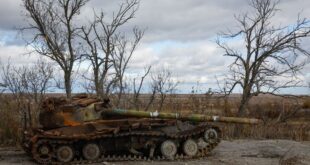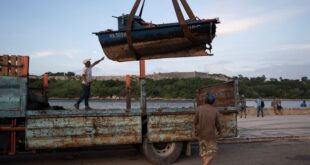CEDAR KEY, Florida (Reuters) -Hurricane Idalia gained strength over the Gulf of Mexico on Tuesday on its relentless crawl toward Florida’s Gulf Coast, forcing evacuations in low-lying coastal areas expected to be swamped when the powerful storm hits on Wednesday.
Idalia was generating maximum sustained winds of 100 miles per hour (161 kph) by early Tuesday evening, but its intensity will ratchet higher before it slams ashore in the early hours of Wednesday, according to the Miami-based National Hurricane Center (NHC).
By that time, the storm was forecast to reach Category 3 strength – classified as a major hurricane, with maximum sustained winds of at least 111 mph (179 kph) – on the five-step Saffir-Simpson wind scale.
The hurricane was upgraded on Tuesday evening to a Category 2 after its top wind speeds surpassed 95 mph (153 kph), feeding on the warm, open waters of the Gulf of Mexico.
Idalia’s most dangerous feature, however, appeared to be the powerful surge of wind-driven seawater it is expected to deliver to barrier islands and other vulnerable areas along the coast.
Florida Governor Ron DeSantis urged residents in low-lying communities to heed orders to seek higher ground, warning that the storm surge could cause life-threatening floods.
“The time is running out very, very rapidly,” he said at an afternoon news briefing.
Mary Wolcott Martino, 79, a travel writer in St. Petersburg, hurriedly packed on Tuesday afternoon, grabbing irreplaceable items such as computer hard drives with family photos.
“We’re leaving in five minutes, headed out the door now,” she said.
She and her husband did not board up their home as they did ahead of last September’s Hurricane Ian, saying they are more concerned about flooding than high winds this time.
“We’re on the canal and just 9 feet above sea level,” she said.
Gulf energy producers were taking precautions as well. U.S. oil company Chevron evacuated staff from three oil production platforms, while Kinder Morgan planned to shut a petroleum pipeline.
Idalia-related disruptions extended to Florida’s Atlantic coast at Cape Canaveral, where the Tuesday launch of a rocket carrying a U.S. Space Force intelligence satellite was delayed indefinitely due to the hurricane.
The NHC said Idalia’s center would likely hit Florida’s coastline somewhere in the Big Bend region, where the state’s northern panhandle curves into the Gulf side of the Florida Peninsula. The area, roughly between the inland cities of Tallahassee and Gainesville, is much more lightly populated than the Tampa-St. Petersburg area to the south.
Most of Florida’s 21 million residents, along with many in Georgia and South Carolina, were under hurricane, tropical storm and storm surge warnings and advisories.
Idalia grew from a tropical storm into a hurricane early on Tuesday, a day after passing west of Cuba, where it damaged homes and flooded villages.
By Tuesday evening, the storm was churning about 195 miles (310 km) southwest of Tampa as it crept northward.
Idalia is in line to become the fourth major hurricane to strike Florida over the past seven years, following Irma in 2017, Michael in 2018 and Ian, which peaked at Category 5, last September.
UP TO 15 FEET OF STORM SURGE
In Sarasota – a city hard-hit by Ian last year – Milton Bontrager’s home was boarded and stocked with food, water and a generator.
“I don’t panic, I prepare,” said Bontrager, 40, who runs six charter fishing boats in Venice along the Gulf Coast near Tampa.
He stopped taking customers out days ago so he could secure the boats. His biggest craft is tied down to a floating dock with 16 lines and equipped with battery-powered pumps that turn on automatically if the boat starts taking on water.
Florida’s Gulf Coast along with southeastern Georgia and eastern portions of North and South Carolina could face torrential rains of 4 to 8 inches (10 to 20 cm) through Thursday, with isolated areas seeing as much as 12 inches (30 cm), the hurricane center warned.
Surge warnings were posted for hundreds of miles of shoreline, from Sarasota to the sport fishing haven of Indian Pass at the western end of Apalachicola Bay. In some areas, the surge of water could rise 10 to 15 feet (3.0 to 4.6 m), the NHC said.
“The No. 1 killer in all of these storms is water,” Deanne Criswell, the Federal Emergency Management Agency’s administrator, said on CNN.
More than 40 school districts in Florida canceled classes, DeSantis said. Tampa International Airport planned to suspend commercial operations at midday Tuesday.
Some 5,500 National Guard troops were mobilized, while 30,000 to 40,000 electricity workers were placed on standby. The state has set aside 1.1 million gallons of gasoline to address any interruptions to fuel supplies, DeSantis said.
BRUSH WITH CUBA
As Floridians braced for Idalia’s arrival, Cubans were grappling with the aftermath of the storm, which lingered for hours on Monday near the western end of the Caribbean island nation, toppling trees and flooding coastal villages.
In Pinar del Rio, an area known for producing the tobacco used to make some of the world’s finest cigars, 60% of the province was without power. Tens of thousands of people were evacuated.
(Reporting by Marco Bello in Cedar Key, Florida, Rich McKay in Atlanta, Nelson Acosta in Havana, Dave Sherwood in Guanimar, Cuba, Joey Roulette in Tampa Bay, Florida, Brad Brooks in Longmont, Colorado, and Brendan O’Brien in Chicago; Writing by Joseph Ax and Steve Gorman; Editing by Lincoln Feast and Marguerita Choy)
 BeritaKini.biz Berita Viral Terkini di Malaysia
BeritaKini.biz Berita Viral Terkini di Malaysia





